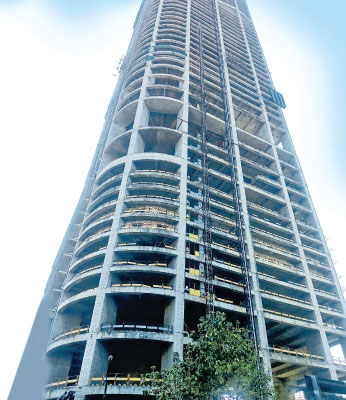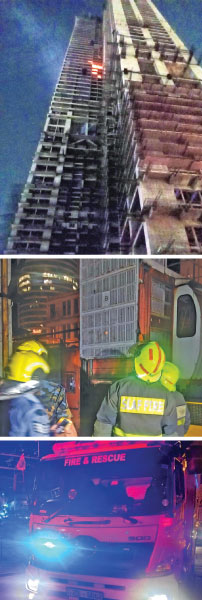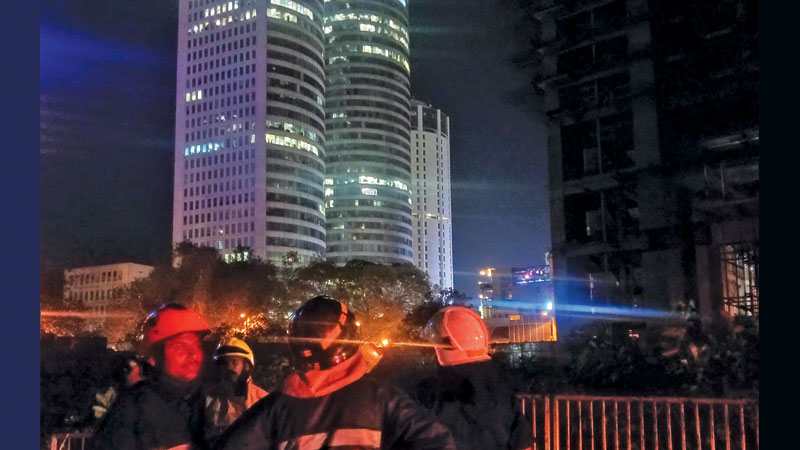Sky scraping marvels such as the Lotus Tower and Altair buildings are a testament to Colombo’s economic prowess, as the capital evolves into one of South Asia’s attractive destinations. But on February 7, a sudden blaze at the Krrish Tower brought the city’s shinning allure into question.
 CMC firefighters and Air Force personnel battled the blaze for four hours as flames spread from the 35th floor to multiple levels.
CMC firefighters and Air Force personnel battled the blaze for four hours as flames spread from the 35th floor to multiple levels.
Since October, the area around the slowly decaying high-rise became a hazard to downtown Fort due to falling debris which damaged a parked car.
Public safety
In December, the Colombo Fort Magistrate ordered the Board of Directors of the company behind the abandoned 60-storey building to remove hazardous construction materials within two weeks for public safety. According to the order, the building was to be maintained to ensure no materials fell and caused harm and any decaying or unsafe materials to be removed.
The legal team representing the company told Court that a plan has been prepared to remove these materials within 55 days, with minimal disruption to traffic. A net was placed to cover the section facing the street. The Court granted the request to involve the State Engineering Corporation to oversee the work.
 Taking up a key piece of real-estate in downtown Fort, the Ritz-Carlton Residencies, which included the Krissh Tower was planned to be a mixed-development project comprising four high-rise buildings with the highest with 90 floors. The project halted due to a combination of factors including financial difficulties, legal disputes with investors, allegations of corruption and the company’s inability to meet construction deadlines, leading to the project becoming mired in controversy and eventually being taken over by the Government in search of a new investor; construction stalled significantly during the pandemic.
Taking up a key piece of real-estate in downtown Fort, the Ritz-Carlton Residencies, which included the Krissh Tower was planned to be a mixed-development project comprising four high-rise buildings with the highest with 90 floors. The project halted due to a combination of factors including financial difficulties, legal disputes with investors, allegations of corruption and the company’s inability to meet construction deadlines, leading to the project becoming mired in controversy and eventually being taken over by the Government in search of a new investor; construction stalled significantly during the pandemic.
However, Colombo’s high-rise residents and office workers have raised concerns when fire teams admitted that they couldn’t extend ladders beyond Krissh Tower’s 30th floor.
The Sunday Observer spoke to several experts on the safety of these highrise buildings.
The Urban Development Authority’s Deputy Director General of Planning in Zone I, M.P. Ranatunga said that a building requires several clearances for fire safety, sewage, solid waste, electricity, water and traffic before approval, “This also includes clearances from the National Building Research Organisation (NBRO), Archaeological Department, Central Environmental Authority and Civil Aviation Authority in certain cases which they apply”.
A fire clearance by the city or the UDA is a must for high-rises, this includes a fire drawing. “There are fire mitigation floors for high-rises. They are required by the Fire Department,” he said adding that he was unsure if the Krissh building had constructed one.
Fire mitigation floors
Fire mitigation floors in buildings are fire-resistant floors that are designed to prevent the spread of smoke and flames. They are part of a building’s fire safety system, which also includes fire-resistant walls, doors and other fire protection systems.
Assistant Chief Fire Officer, W. Dayananda of the Colombo Municipal Council Fire Brigade said, “When buildings are at the design stage, the developers come to us with blueprints. We give them the necessary requirements according to design, be it a low-rise, medium-rise or high-rise or super high-rise and floor area. The building’s construction work should follow this checklist”.
However, most of the safety features that were supposed to be in place for the Krissh Tower weren’t built because construction was halted. One of the features was a ‘Hard-Standing’ which is a paved or hard-surfaced area around a building, typically made of concrete or asphalt, designed to withstand heavy loads and provide a stable surface for parking vehicles, storing materials, or other operational activities; essentially, a solid, durable ground area around the building used for various purposes such as loading bays or vehicle access. “Because this building was halted in mid-construction, we couldn’t access certain areas. You need a Hard-Standing to park a 40 ton vehicle such as a fire truck; from which we start operating,” he said adding that the approvals were given but the company behind Krissh Tower had not built those fail-safes.
“That night, the fire-fighters couldn’t even use the elevator to access certain floors and there were no fire lines”, Dayananda said highlighting the lack of safety infrastructure.
Safety systems lacking
 He said the narrative that the Fire-Department was not equipped to fight the fire was false. “Our machines can only extend 64 metres. That’s why we request contractors to install certain safety systems; like two fire pumps – in case one fails. There is also something called the fire fighting lift. You can’t find these in an incomplete building,” he said.
He said the narrative that the Fire-Department was not equipped to fight the fire was false. “Our machines can only extend 64 metres. That’s why we request contractors to install certain safety systems; like two fire pumps – in case one fails. There is also something called the fire fighting lift. You can’t find these in an incomplete building,” he said.
There is this notion in Sri Lanka that fire-fighters should run helter-skelter when they arrive at an emergency. “This is not true. We have to analyse the situation first. A lot of planning goes into fire fighting,” he said adding that it is best advised for onlookers to keep a safe distance and not to interfere with the operation.
The cause of the fire is said to be a spark from a metal grinder that had ignited a pile of plywood in the floors below.
“I assume that the Court order had stipulated that the material should be removed. The people who are in charge should practise due diligence without wantonly stripping the building,” he said.
The State Engineering Corporation’s (SEC) General Manager, Jude Bernard said that the observation report for the Police had been completed. He said that the SEC is not involved any further. However, the Fort Police said they had not received the report.
On the night of February 7, the Sunday Observer was at the scene and met a Chartered Accountant, the Court-appointed liquidator of the building, Sugath Kumar. “They have been instructed to remove the steel. The boards were removed and some of them have disintegrated into dust; most of it has fallen into the lift shaft. We are complying with the Court order. The company is facing financial constraints as it is under liquidation. This company is bankrupt. There are no utilities on the site; no water and no fire extinguishers. However, previous contractors had safety standards in place,” he said.
There was a pile of planks and plywood on the ground and according to Kumar, the work crews are stripping the wood and storing them on some floors so they can be lowered from the tower crane.
When asked about the lack of safety officers, Kumar said that this was not a typical construction site and the fact that the building has been an arrested development for over four years had made it volatile.
The Krrish Tower fire underscores the challenges posed by incomplete high-rises—particularly when construction has been abandoned for years. While Colombo’s skyline continues to grow, this incident highlights the need for clear regulatory enforcement to ensure that stalled projects do not become safety hazards.
Ensuring proper oversight of unfinished structures, enforcing safety regulations even on sites in legal or financial limbo, and enhancing Colombo’s firefighting capabilities for high-rise incidents should be key priorities moving forward.
Pictures by Sulochana Gamage









